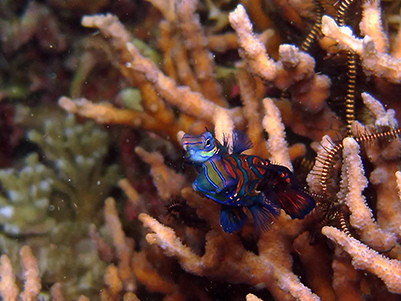Reproduction
Synchiropus splendidus like other animals has a unique spawning ritual that involves the courting of the female fish by the male fish. Mandarinfish are known to be polygynandrous (Encyclopedia of Life). The mating system polygynandrous is defined as a “sexual sharing among two or more females and two or more males” (Word Press). The spawning occurs above the reef where the males and females live. Mating occurs during the night hours and happens externally when the males and females come in contact with each other they release both their eggs and sperms into the water around them (Encyclopedia of Life). Mandarinfish are pelagic spawners. A pelagic spawning is best described as the release of numerous buoyant eggs that are dispersed by the currents in the water (Reef Culture Technologies). Some other examples of other pelagic spawners are the albacore tuna, the paddlefish, and the pink skunk clownfish.
When the mating takes place there is oftentimes competition
among the males since females only spawn once a night and can go a
few days without spawning again (Encylopedia of Life). It has been
found that mating occurs in the evening within 20 minutes of the
sunset when the females emerge in groups waiting to be courted by
the male mandarinfish (Mayell 2001). The larger males are generally
more successful in mating because the females have a sexual
preference to larger males (Sandovy 2001). When the female and male
pick their mates for the night the female approaches the male and
rest on the pelvic fin of the male. As the two fish rise
they release eggs and sperm into the water (Mayell, 2001).

When spawning takes place between the female and males it can occur weekly throughout the year and continues year round (Encyclopedia of Life). When spawning occurs up to 200 eggs can be released into the water to combine with the sperm of the male fish (Encyclopedia of Life). Once the egg and sperm are fertilized the parents have no involvement in caring for the eggs because of the larger amount of eggs that are dispersed into the water. The incubation time for these fertilized eggs is averaged at 12 hours for each egg (Encyclopedia of Life). Many of the eggs result in mortality though because they are consumed by other fish that are in the same water environment where the eggs are incubate. To learn more about the geographical location of where these fish lay their eggs, visit the habitat page.
To learn more about how this organism interacts with other species, click here!
To return back to the home page, click here!